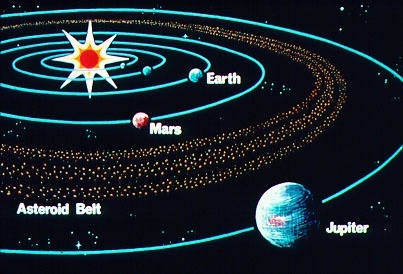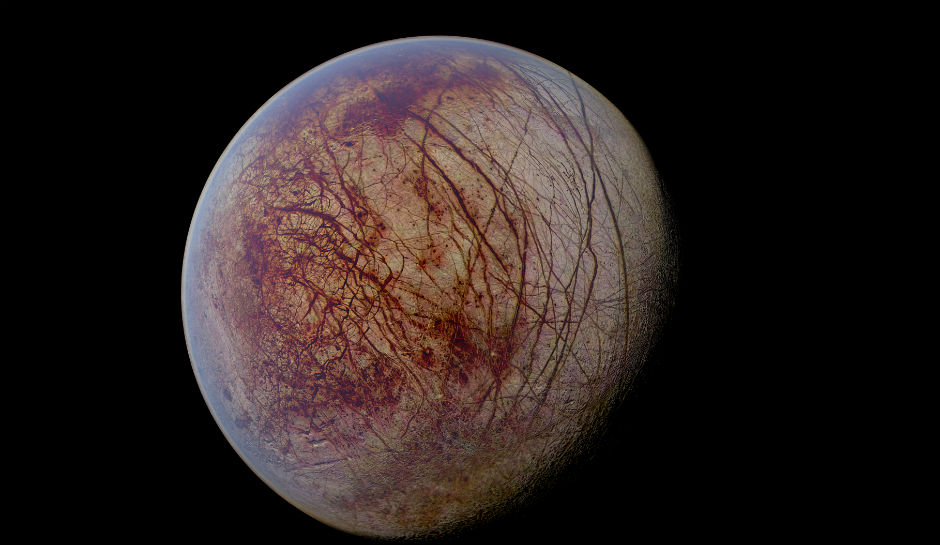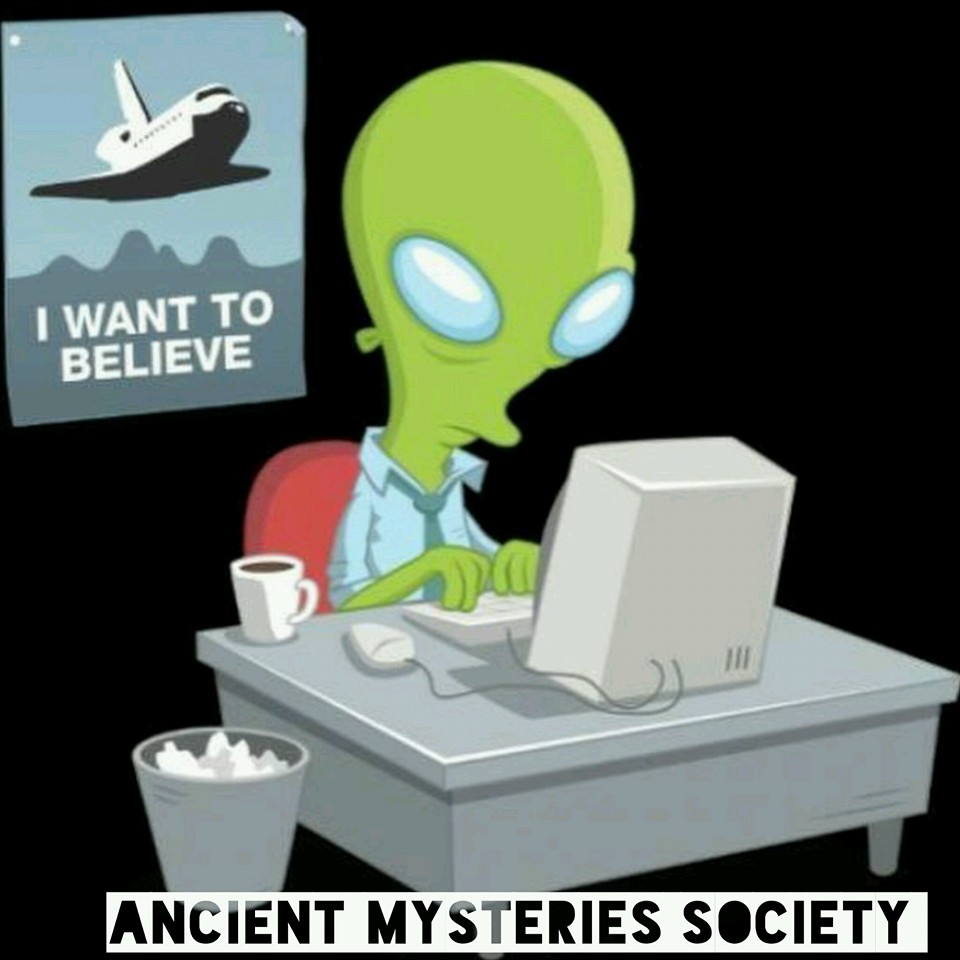It looks like you're using an Ad Blocker.
Please white-list or disable AboveTopSecret.com in your ad-blocking tool.
Thank you.
Some features of ATS will be disabled while you continue to use an ad-blocker.
8
share:
Between Mars and Jupiter is the Asteroid Belt, remnants from the early days of our Solar
System. These are chunks of rock and stone, and also some iron and nickel - Jupiter's gravity is believed to have prevented these materials from
forming a planet, and thus they remain floating about. The more distant asteroids also have some ice.

The largest "body" in the asteroid belt is known as Ceres - it is large enough to have been classified as a "dwarf planet" back in 2006, and is the only of its kind in the inner solar system.
Scientists believe Ceres may have oceans of liquid water under the surface, and organic compounds have also been discovered near an area known as the Ernutet crater. Furthermore, the asteroid belt is exposed to "comparatively low radiation levels" (as stated in the article excerpt below).

From the article:
Link
If you remember last year, Ceres is also home to those odd "bright spots" that many of us discussed on ATS (thread).
More on Ceres:
Ceres - Overview (NASA)
As many of you know, Jupiter's moon Europa is also home to under-the-surface oceans, and many believe Europa to actually be the most likely place for life in our Solar System (other than the one and only EARTH): www.space.com...

It makes you wonder.


The largest "body" in the asteroid belt is known as Ceres - it is large enough to have been classified as a "dwarf planet" back in 2006, and is the only of its kind in the inner solar system.
Scientists believe Ceres may have oceans of liquid water under the surface, and organic compounds have also been discovered near an area known as the Ernutet crater. Furthermore, the asteroid belt is exposed to "comparatively low radiation levels" (as stated in the article excerpt below).

From the article:
Ceres itself, the largest known body in the asteroid belt, has been found to be home to organic compounds, specifically from the methyl and methylene groups, clustered around the crater called Ernutet. Researchers believe the compounds weren't deposited there by another body -- the heat from a collision would have destroyed the molecules -- but rather, the still-unidentified substance developed there, native to its dwarf planet home.
Ceres shows signs of having an ocean of liquid water under its mantle of ice, and might very well have a source of heat from within keeping the water warm. Along with the comparatively low radiation exposure the bodies of the asteroid belt are under, organic compounds present there could very well have provided the foundation for life forms that formed there, even if it is just single-celled organisms.
Link
If you remember last year, Ceres is also home to those odd "bright spots" that many of us discussed on ATS (thread).
More on Ceres:
Dwarf planet Ceres is the largest object in the asteroid belt between Mars and Jupiter and the only dwarf planet located in the inner solar system.
Called an asteroid for many years, Ceres is so much bigger and so different from its rocky neighbors that scientists classified it as a dwarf planet in 2006.
... Ceres comprises 25 percent of the asteroid belt's total mass...
Ceres - Overview (NASA)
As many of you know, Jupiter's moon Europa is also home to under-the-surface oceans, and many believe Europa to actually be the most likely place for life in our Solar System (other than the one and only EARTH): www.space.com...

It makes you wonder.

edit on 9-3-2017 by FamCore because: added pics
a reply to: intrptr
You could easily be right, I'm not very well versed in astrophysics and my commentary about Jupiter's gravity being a factor came from the Space.com link on the Asteroid Belt.
I hadn't thought about the fact that the inner solar system has "solid planets" and the outer solar system is mainly made up of gaseous ones. What a fascinating cosmic neighborhood we have. Space is completely MIND BLOWING to me on every possible level
You could easily be right, I'm not very well versed in astrophysics and my commentary about Jupiter's gravity being a factor came from the Space.com link on the Asteroid Belt.
I hadn't thought about the fact that the inner solar system has "solid planets" and the outer solar system is mainly made up of gaseous ones. What a fascinating cosmic neighborhood we have. Space is completely MIND BLOWING to me on every possible level
I don't think the asteroid belt has any large enough bodies to start and support a civilization. Now if they are looking I would suppose they would be
looking for something that we ourselves will have to do and that's mining.
It would be vastly better to mine the asteroid belt that mine a planet as the elements are already exposed so no large terrain moving equipment would be needed to expose the elements. So maybe they are looking for evidence of industrial activity not a civilization.
It would be vastly better to mine the asteroid belt that mine a planet as the elements are already exposed so no large terrain moving equipment would be needed to expose the elements. So maybe they are looking for evidence of industrial activity not a civilization.
a reply to: crayzeed
If there is life in the Asteroid Belt it is likely microbial or single-celled organisms.
Mining in space is a concept I would love to see come to fruition in my lifetime, if it can be done in a way that makes it worthwhile considering the massive amount of resources that would need to be used to get up there, mine, and then transport those materials.
Thanks for your contribution
If there is life in the Asteroid Belt it is likely microbial or single-celled organisms.
Mining in space is a concept I would love to see come to fruition in my lifetime, if it can be done in a way that makes it worthwhile considering the massive amount of resources that would need to be used to get up there, mine, and then transport those materials.
Thanks for your contribution
a reply to: FamCore
I think if we have the will we can do it.
It all comes down to resources, but who dictates what the resources are and what cost.
Let me give you one of my ultra altruistic thoughts to think on. Question:- how much did it take to put a man on the moon?
Billions, trillions? Now think on this and let your mind run riot.
What ifs. What if the people who mined the materials for the operation gave NASA the required material. What if the people who made the rockets and equipment gave NASA their work for free. What if NASAs people worked for free and all other materials and expertise was given for free.
Now tell me how much it would cost to put a man on the moon?
That of course is over simplifying the problem but the gist is it's only mans greed that hold us back.
I think if we have the will we can do it.
It all comes down to resources, but who dictates what the resources are and what cost.
Let me give you one of my ultra altruistic thoughts to think on. Question:- how much did it take to put a man on the moon?
Billions, trillions? Now think on this and let your mind run riot.
What ifs. What if the people who mined the materials for the operation gave NASA the required material. What if the people who made the rockets and equipment gave NASA their work for free. What if NASAs people worked for free and all other materials and expertise was given for free.
Now tell me how much it would cost to put a man on the moon?
That of course is over simplifying the problem but the gist is it's only mans greed that hold us back.
a reply to: FamCore
I guess science is after a "rethink" about the asteroids. Forever they have contended that the asteroids were the residue left over from the forming of the planets. The refused to even consider that material once was a planet that was disrupted.
Why would they be talking about life and the building blocks for life on old, relatively small areas raw materials that have nor never had any type of an atmosphere and no chance to go through the processes that is believed to create life? Chunks of material out there containing "oceans" of water? Evidently, the asteroids, some of them, are not quite the simple rocky debris assumed. Do they have other concepets to eventually release upon us about this new turn in astronomy?
I'll venture to say that the mysterious voids found on Mars' Phobos and the water also found there--beyond the mysterious markings, has allowed them to suspect that Phobos was, actually, an asteroid and it was moved into its very uncommon orbit by ETIs long ago.
If Phobos is a former asteroid habitat created by ETIs, where does that end? Was that the manner the Martians used for escape from a dying planet? Are some of the asteroid that "buzz" the inner system habitats?
My whole point has been that for science to be pointing a finger at trivial asteroids as signs for compounds that could support or eventually become life, then where does that leave us in regards to Mars, and our other ambitious searches for life in distant places? It means they are attempting to make you more and more comfortable with other life in the galaxy.
I guess science is after a "rethink" about the asteroids. Forever they have contended that the asteroids were the residue left over from the forming of the planets. The refused to even consider that material once was a planet that was disrupted.
Why would they be talking about life and the building blocks for life on old, relatively small areas raw materials that have nor never had any type of an atmosphere and no chance to go through the processes that is believed to create life? Chunks of material out there containing "oceans" of water? Evidently, the asteroids, some of them, are not quite the simple rocky debris assumed. Do they have other concepets to eventually release upon us about this new turn in astronomy?
I'll venture to say that the mysterious voids found on Mars' Phobos and the water also found there--beyond the mysterious markings, has allowed them to suspect that Phobos was, actually, an asteroid and it was moved into its very uncommon orbit by ETIs long ago.
If Phobos is a former asteroid habitat created by ETIs, where does that end? Was that the manner the Martians used for escape from a dying planet? Are some of the asteroid that "buzz" the inner system habitats?
My whole point has been that for science to be pointing a finger at trivial asteroids as signs for compounds that could support or eventually become life, then where does that leave us in regards to Mars, and our other ambitious searches for life in distant places? It means they are attempting to make you more and more comfortable with other life in the galaxy.
Not true and not true. They haven't considered asteroids were leftovers "forever" and they did consider the asteroids to be remnants of a larger planet, in fact that was the idea suggested by the discoverer of the asteroids, German astronomer Heinrich Wilhelm Matthias Olbers.
originally posted by: Aliensun
a reply to: FamCore
I guess science is after a "rethink" about the asteroids. Forever they have contended that the asteroids were the residue left over from the forming of the planets. The refused to even consider that material once was a planet that was disrupted.
On March 28, 1802, Olbers discovered and named the asteroid Pallas. Five years later, on March 29, 1807, he discovered the asteroid Vesta, which he allowed Carl Friedrich Gauss to name. As the word "asteroid" was not yet coined, the literature of the time referred to these minor planets as planets in their own right. He proposed that the asteroid belt, where these objects lay, was the remnants of a planet that had been destroyed.
Of course that's not the consensus view today, but this should help you understand that at least it was considered at some point in the past; in some sense you could say this was the first idea since it was proposed by the discoverer.
I'm not aware of any reason why ice-bearing asteroids couldn't have some warmer spots where melted ice could support life, but I doubt it could support complex life, perhaps just microbes.
edit on 201739 by Arbitrageur because: clarification
new topics
-
God's Righteousness is Greater than Our Wrath
Religion, Faith, And Theology: 2 hours ago -
Electrical tricks for saving money
Education and Media: 5 hours ago -
VP's Secret Service agent brawls with other agents at Andrews
Mainstream News: 7 hours ago -
Sunak spinning the sickness figures
Other Current Events: 7 hours ago -
Nearly 70% Of Americans Want Talks To End War In Ukraine
Political Issues: 8 hours ago -
Late Night with the Devil - a really good unusual modern horror film.
Movies: 10 hours ago -
Cats Used as Live Bait to Train Ferocious Pitbulls in Illegal NYC Dogfighting
Social Issues and Civil Unrest: 11 hours ago
top topics
-
VP's Secret Service agent brawls with other agents at Andrews
Mainstream News: 7 hours ago, 9 flags -
Cats Used as Live Bait to Train Ferocious Pitbulls in Illegal NYC Dogfighting
Social Issues and Civil Unrest: 11 hours ago, 8 flags -
Electrical tricks for saving money
Education and Media: 5 hours ago, 4 flags -
HORRIBLE !! Russian Soldier Drinking Own Urine To Survive In Battle
World War Three: 15 hours ago, 3 flags -
Nearly 70% Of Americans Want Talks To End War In Ukraine
Political Issues: 8 hours ago, 3 flags -
Sunak spinning the sickness figures
Other Current Events: 7 hours ago, 3 flags -
Late Night with the Devil - a really good unusual modern horror film.
Movies: 10 hours ago, 2 flags -
The Good News According to Jesus - Episode 1
Religion, Faith, And Theology: 13 hours ago, 1 flags -
God's Righteousness is Greater than Our Wrath
Religion, Faith, And Theology: 2 hours ago, 0 flags
active topics
-
New whistleblower Jason Sands speaks on Twitter Spaces last night.
Aliens and UFOs • 55 • : baablacksheep1 -
VP's Secret Service agent brawls with other agents at Andrews
Mainstream News • 40 • : ThatSmellsStrange -
Cats Used as Live Bait to Train Ferocious Pitbulls in Illegal NYC Dogfighting
Social Issues and Civil Unrest • 20 • : Asher47 -
Nearly 70% Of Americans Want Talks To End War In Ukraine
Political Issues • 12 • : Asher47 -
Electrical tricks for saving money
Education and Media • 4 • : Lumenari -
DONALD J. TRUMP - 2024 Candidate for President - His Communications to Americans and the World.
2024 Elections • 514 • : WeMustCare -
The Acronym Game .. Pt.3
General Chit Chat • 7744 • : bally001 -
Truth Social goes public, be careful not to lose your money
Mainstream News • 128 • : Astyanax -
Sunak spinning the sickness figures
Other Current Events • 5 • : glen200376 -
SETI chief says US has no evidence for alien technology. 'And we never have'
Aliens and UFOs • 44 • : MikeDeGrasseTyson
8
